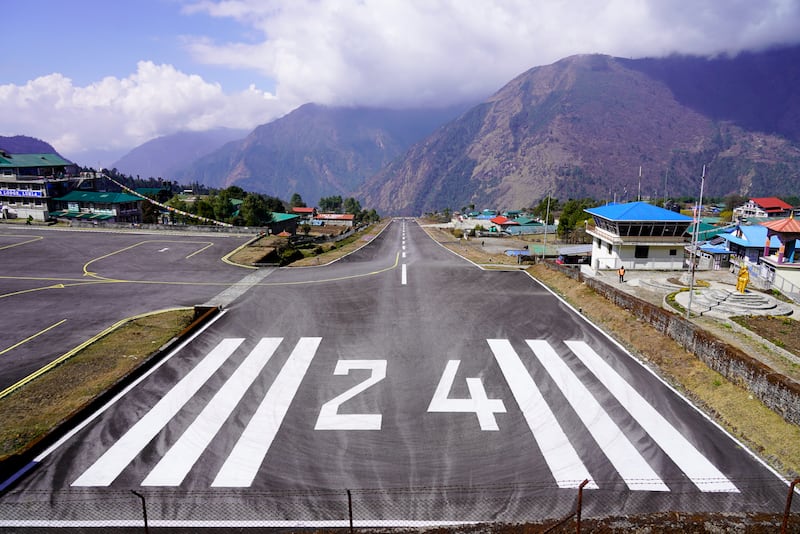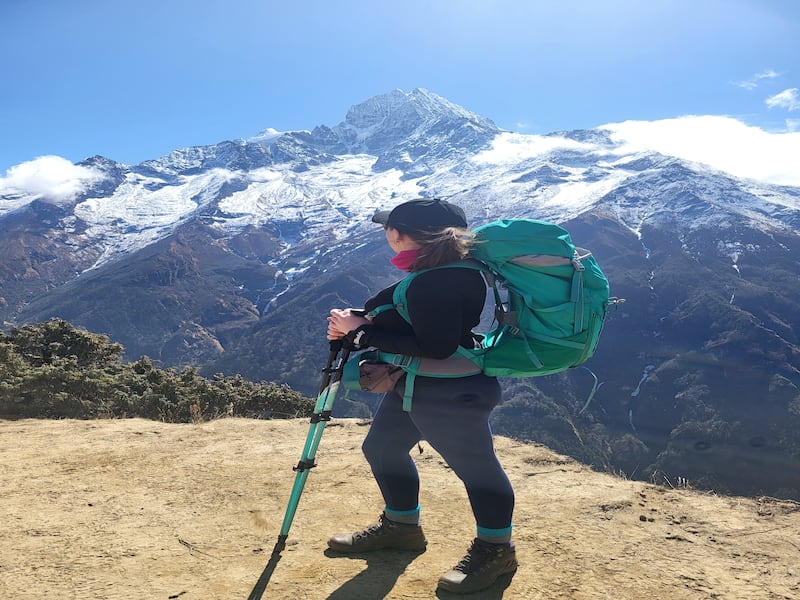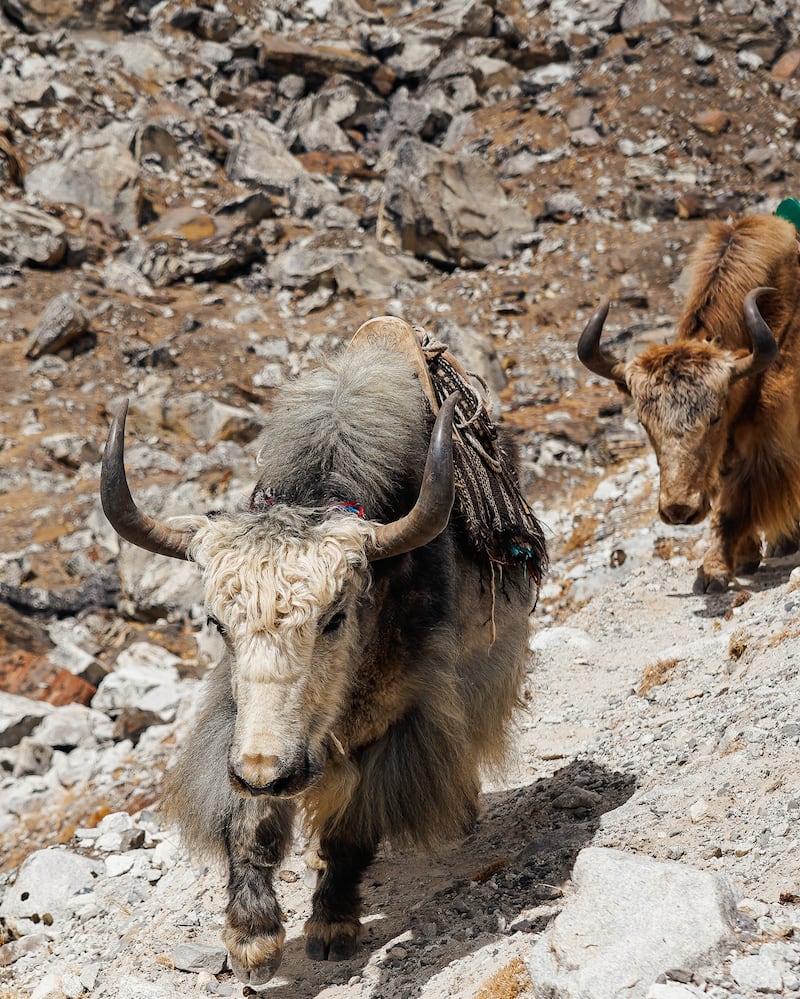Deep in the Himalayas, I’m Gonna Be (500 miles) by the Proclaimers is playing through a Bluetooth speaker. A total of 13 Irish hikers are singing along, their trekking poles rising and falling like the call-and-response chant that is soundtracking their journey.
Thankfully for these holidaymakers, the trekking expedition is only a 130km round-trip to Everest Base Camp, rather than the 1,000 miles we are singing about.
The group embarked on a flight from Dublin to Kathmandu a few days earlier, beginning the trip to the base camp of the highest mountain in the world.
The adventure starts almost as soon as you arrive in Nepal. After a brief break in Kathmandu where we shower, rest up and eat, we must wake up not long after midnight to continue our journey.
READ MORE
We grab our rucksacks and duffel bags and board a bus that will bring us on a four-hour journey to Ramechhap. This is a journey that will forever more be burned into my mind. Between the obstructed roads that required us to go into a ditch to circumvent mounds of sand, the cliff edge we drove along, and the ear-piercing brakes, the plans for a nap were abandoned.
Finally, we arrive at Ramechhap airport. If it wasn’t for the arrival and departure of planes you would struggle to convince me that this small, rundown building is, in fact, an airport. Our flight to Lukla is due to be one of the first out that morning. There are enormous crowds of people with heavy bags.
Lukla is often referred to as one of the most dangerous airports in the world, due to its runway being just 527 meters long, right off a cliff edge. This means if there is wind or cloud or any other adverse weather, flights are delayed indefinitely.
A few tepid screams fill the air as we look through the cockpit of the small propeller plane and see the tiny runway
This is something we realise after waiting in intense heat for six hours, with only six hours of sleep over the previous two days. Ah, adventure.
Eventually, our head guide Gyaltsen Sherpa decides to book us into accommodation nearby, realising our flight would not be leaving that day. Though we appreciate having somewhere to lay our heads, the area is not touristy by nature and there were some unexpected rodent and reptile room guests. Trips like this are all about who you meet along the way.
The next morning, with much bated breath, our flight takes off. A few tepid screams fill the air as we look through the cockpit of the small propeller plane and see the tiny runway we’re heading towards, we land in Lukla.
After some breakfast, we begin our first day of trekking. It is a short day, consisting of three hours, and we arrive at Phakding for our first experience of a tea house.


The tea house accommodation is basic but far better than any of us envisaged. The rooms comprise two single beds, many of which have blankets and pillows. The rooms are cold, however, with trekkers congregating in the communal area.
Here, on night one on the trail, the card games began. Sitting around tables with a heater in the middle of the room, we drink tea and play card games.
Day two is a more difficult endeavour. The trail to Everest base camp is quite undulating, but the second day felt steep. Don’t look up, we told ourselves, but you could always tell when someone did from the quiet moan of desperation they would release.
[ Dozy dozen: 12 of the best spots to get 40 winks in Ireland and overseasOpens in new window ]
The journey also provided wonderful views of the Dudh Kosi river with several suspension bridges that must be crossed along the way. The final suspension bridge – there are 16 in total – is the infamous Hillary bridge. Once we cross that there is one final push upwards through a pine forest before we reach Namche Bazaar.
Here, you would almost forget where you are and what you are doing. It is a bustling market town, filled with shops of every type: hiking gear, pizza restaurants, coffee shops, trinkets and souvenirs.
Most importantly, Namche Bazaar contains the world’s highest Irish pub. Here, we teach our local guides how to Irish dance, sing the Cranberries with all our might and have some competitive games of pool.
We are advised to go vegetarian for the duration of the trip, which means as a result we eat a lot of carbohydrates: vegetable fried potatoes, vegetable fried rice, vegetable fried noodles and vegetable springrolls feature heavily throughout.
The impact of climate change on the ever-shrinking Khumbu glacier is undeniable.
By the third or fourth day, we have already begun to fantasise about the KFC we intend to consume in the airport on the way home.
We spend two days at Namche Bazaar, one of which is an acclimatisation day, which is where you do a local hike to give your body time to become accustomed to the higher altitude. And then we continue our journey upwards, visiting villages such as Pheriche, Phortse and Gorakshep along the way.
The day you reach base camp is challenging. Situated at 5,365 metres high, you’re at an altitude that those from Ireland are completely unfamiliar with. As a result, some on the team suffered with altitude sickness including nausea, headaches, fatigue and an inability to sleep properly.
Base camp is also, quite honestly, underwhelming. There are queues of people trying to snake their way to the infamous rock that marks your arrival at the camp, with another queue of people trying to work their way back. On the ground, there is a surprising number of discarded cigarette butts, while the impact of climate change on the ever-shrinking Khumbu glacier is undeniable.
But that doesn’t detract from the sense of achievement or enjoyment. You see only the summit of Everest from Base Camp, but you do get fantastic views of the Khumbu icefall, a wall of ice that is often considered the most dangerous part of attempting to summit Everest.
On a trip like this, it is the views along the way that are much more rewarding; it is about the journey, rather than the destination.
The following day after reaching base camp, several people in the group choose to climb up Kalla Patthar (5,500m) for sunrise, to catch some incredible views of Everest and the surrounding mountains, before we all begin our descent.
One element of this expedition that makes it markedly different from a mountain summit attempt is the long time between reaching your goal and completing the trek. It is four days back down from base camp. And since the terrain was undulating on the way up, it is a similar experience on the way back down.
In all, it is 13 days of trekking, though ours is cut short by a day due to the initial travel disruption. This meant we have one extremely long day on our descent, being on our feet for 10 hours straight. You can overhear the whispers ‘Why did we decide to do this again?’ among the group.
It is not a cheap trip, coming in at around €4,700, but you truly feel as though you get value for money. We booked our trip through Irish company Earth’s Edge, meaning an international doctor and guide accompanied us. Our doctor, Ankur Gupta, was there if we needed anything: advice, plasters, medication.


The fee also included flights, accommodation, and food and drink for the duration of the trip. You’re also provided with the opportunity to fully immerse yourself in local Nepalese culture, trekking through villages throughout the holiday. There is a sherpa museum and monasteries along the way, and we are lucky enough to witness a Buddhist monk praying in the Tengboche monastery on the day we are there.
Just before we return to the gates through which our initial journey began, and which is our final hurdle, we come across another group of Irish trekkers who are beginning their adventure. “Well, at least you’re still smiling anyway,” they remark as we continue our ‘90s-themed singsong.
We decide against telling them the reason for our smile is knowing the end is near and we can shortly put our feet up.
We continue singing, moving on to the Spice Girls, as we head towards the village of Lukla, where we will be staying for the night. We stumble across another Irish bar, and since our trek is finally over, we feel obliged to visit.
As we walk into the premises, there is a sign pointing downstairs. We follow this and enter a dingy nightclub, with Irish flags draped across the walls. Techno music is blaring. Out-of-date cider is being opened. Sure, what else would you be doing at 2.30pm?
At this point, we think our adventure is over. Little do we know, there are more bumps along the way. Our domestic flight from Lukla to Kathmandu is postponed due to weather. But there is no indication as to when flights will resume, meaning we sit near the airport for hours on end.
It is the following day before we can finally leave. When our plane lifts off from the runway, creating a sensation akin to a rollercoaster, there are cheers of relief that we are finally en route home.
The trip to Everest Base Camp is a wonderful challenge, but it also wouldn’t be possible without excellent guides; Josie McGee was a constant bundle of energy, while our local guides couldn’t help but laugh at our antics.
It is an extraordinary – albeit long – holiday. The expedition requires no technical climbing skills, just a good level of fitness and a strong mentality to keep pushing yourself forward. This means that pretty much anyone who fits the above criteria and who has a desire to reach the base camp of the world’s tallest mountain is more than capable.

















